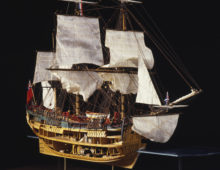Tagged with Napoleonic Wars
Resource : Prosthetic leg of Earl of Uxbridge
This is one of three prosthetic legs made for Henry Paget, Earl of Uxbridge, who commanded the British cavalry at the Battle of Waterloo.
Resource : The Fighting Temeraire
JMW Turner is one of Britain’s best loved artists. He became known as the ‘painter of light’ due to his trademark style and use of colour in landscapes and seascapes. The Fighting Temeraire, one of his most famous oil paintings, shows the warship Temeraire being towed by a steam-powered tug on its last ever journey before being broken up. It is said to symbolise the decline of Britain’s naval power, the passing of the ‘glorious’ age of sail and the growth of ‘modern’ technology in an increasingly industrialised Britain. The industrial revolution and the history of the Royal Navy were therefore both saluted, through Turner’s revolutionary brand of romantic landscape painting.
Resource : Napoleon’s Hat
This hat was worn by the French Emperor Napoleon when he commanded the French Army at the Battle of Waterloo. The hat was a vital part of the image of a hard-working, down-to-earth leader that Napoleon tried to create. His profile was instantly recognisable to French soldiers, most of whom were devoted to him. The red, white and blue cockade, pinned to the hat, is a symbol of the French Revolution.
Resource : Chamber pot with Napoleon’s head
In the early 1700s, most potteries were small, family-run businesses with pieces being handmade using traditional methods. The industrial revolution transformed the production of pottery (and other goods) in Britain, meaning it could now be mass produced – on a scale previously unimagined. Pottery designers and manufacturers like Wedgewood and Spode were among the most successful pottery industrialists of the time, becoming household names.
Resource : Musket: ‘Brown Bess’
Resource : A pair of ‘Wellington boots’
These are the original ‘Wellington boots’, designed for the Duke of Wellington to be both practical and fashionable. They were adapted from the ‘Hessian’ boots previously worn by British officers to allow the wearing of new lightweight linen trousers rather than traditional woollen ones. They were cut lower to make riding more comfortable, and no longer had a tassel. After the Duke’s victory at Waterloo, this style of boot became extremely fashionable and spread through London society, eventually inspiring the modern ‘welly’.
Resource : Waterloo Descendants Book addition offers link to American Industrial Revolution
August 27, 2019 - Richard Moss
A new upload to the Waterloo Descendants Book uncovers the story of a Waterloo veteran with a family link to the American Industrial Revolution Waterloo 200 launched the Waterloo Descendants Book with the online Book Company in 2015 to feature the untold stories of the soldiers who fought at the Battle of Waterloo. Descendants and […]
Resource : Battlefield Injuries Illustrated by Charles Bell
This entry includes graphic illustrations of war injuries which some may find upsetting.
This is a watercolour painting by Charles Bell, a British Army surgeon who helped to treat the wounded after the Battle of Waterloo. His haunting paintings are stark reminders of what early 19th century battle injuries were like. They are rare images executed by a practising surgeon and artist, which was an unusual combination. While his portraits powerfully show the agony and trauma experienced by these young men, they also describe their wounds with anatomical accuracy.
Resource : Dartmoor Prison and English Barracks
Dartmoor prison was built between 1806 and 1809, mainly to confine thousands of prisoners of war. It was built in Princetown, a bleak part of Dartmoor and an ideal location because of its remoteness. It was designed by Daniel Asher Alexander, with buildings arranged like the spokes in a wheel, surrounded by a high perimeter wall. It was one of Britain’s first purpose-built prisons designed for 6,000 prisoners, and still remains a prison today, though now with a maximum capacity of just 659.
Resource : The Plumb-Pudding in Danger
This print was one of over a thousand satires produced by the celebrated caricaturist, James Gillray, who became known as the ‘father of the political cartoon’. In the 18th century, cartoons and caricatures were a popular way of mocking the establishment and calling them to account. They would be discussed and enjoyed in shop windows, coffee houses and taverns. The arrival of the industrial printing press in the 1800s helped to spread them far and wide, through broadsides (posters), newspapers and pamphlets. This one was inspired by the resumed hostilities and ongoing rivalry between Britain and France in 1805.


